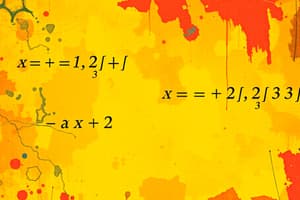Podcast
Questions and Answers
What does the reflexive property of equality state?
What does the reflexive property of equality state?
- For all real numbers a, a = a (correct)
- For all real numbers a and b, if a = b, then b = a
- For all real numbers a, b, and c, if a = b and b = c, then a = c
- For all real numbers a, b, and c, if a = b then a + c = b + c
What does the symmetric property of equality state?
What does the symmetric property of equality state?
- For all real numbers a and b, if a = b, then b = a (correct)
- For all real numbers a, a = a
- For all real numbers a, b, and c, if a = b then a + c = b + c
- For all real numbers a, b, and c, if a = b and b = c, then a = c
What does the transitive property of equality state?
What does the transitive property of equality state?
- For all real numbers a, b, and c, if a = b then a + c = b + c
- For all real numbers a and b, if a = b, then b = a
- For all real numbers a, b, and c, if a = b and b = c, then a = c (correct)
- For all real numbers a, a = a
What does the addition property of equality state?
What does the addition property of equality state?
What does the subtraction property of equality state?
What does the subtraction property of equality state?
What does the multiplication property of equality state?
What does the multiplication property of equality state?
What does the division property of equality state?
What does the division property of equality state?
Flashcards are hidden until you start studying
Study Notes
Properties of Equality
- Reflexive Property of Equality: Any real number is equal to itself, expressed as ( a = a ).
- Symmetric Property of Equality: If one real number equals another, the reverse is also true; if ( a = b ), then ( b = a ).
- Transitive Property of Equality: A chain of equalities leads to a conclusion of equality; if ( a = b ) and ( b = c ), then ( a = c ).
Addition and Subtraction Properties
- Addition Property of Equality: If two numbers are equal, adding the same number to both sides maintains the equality; if ( a = b ), then ( a + c = b + c ).
- Subtraction Property of Equality: Similar to addition, subtracting the same number from both sides of an equation preserves equality; if ( a = b ), then ( a - c = b - c ).
Multiplication and Division Properties
- Multiplication Property of Equality: Multiplying both sides of an equality by the same non-zero number keeps the equality intact; if ( a = b ), then ( ac = bc ).
- Division Property of Equality: Dividing both sides of an equality by the same non-zero number maintains equality; if ( a = b ) and ( c \neq 0 ), then ( \frac{a}{c} = \frac{b}{c} ).
Studying That Suits You
Use AI to generate personalized quizzes and flashcards to suit your learning preferences.




